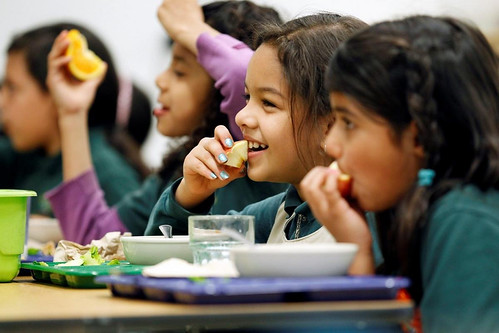
It’s hard to believe the start of the school year is right around the corner. It feels like just yesterday the final bell rang, and students exchanged their pens and pencils for swim trunks and sunglasses. But it’s time for students, teachers and other school staff to get ready for the year ahead, and that includes school nutrition professionals who will soon be tasked with serving healthy school meals to over 30 million students nationwide.
This past year, America’s school nutrition professionals did some phenomenal work, and I look forward to picking up right where we left off. Today, more than 96 percent of schools are successfully meeting the updated meal standards, serving healthy meals approved by nutritionists and students alike. A recent study found that kids are now eating 16 percent more vegetables and 23 percent more fruit at school -- not to mention more whole grains, low-fat dairy, and lean protein, than they were before the new meal standards. I’m certain that through continued collaboration with our partners and food professionals, this school year will bring even more progress toward a healthier, hunger-free generation.
Among our priorities is ensuring access to healthy food in high-poverty communities. Across the country, schools and districts of all sizes have implemented the Community Eligibility Provision (CEP) and are seeing increased participation in the National School Lunch and School Breakfast programs. CEP allows low-income school districts the option to eliminate household applications for free-and-reduced-price meals, providing meals at no cost to all students, rather than just a select few. Heading into this academic year, schools and districts in all 50 states and the District of Columbia have signed on to participate in CEP.
USDA is also prioritizing thorough, ongoing trainings which will help build a healthier future for all Americans. Our Team Up for School Nutrition Success initiative, launched in November 2014, provides schools with trainings on topics such as financial management, youth engagement tactics, and menu planning that are tailored to meet the diverse needs of all communities. We also offer a host of specialized resources for school food service staff on everything from food safety, meal planning, and professional standards to recipes, food presentation tips, and guidance on utilizing local produce. USDA understands that by training leaders locally, we can expand our reach tremendously and by empowering mentors at the state and local level, we provide communities with lasting, personalized support that is there to stay.
Let’s work together to continue the success of school meal programs, fight childhood hunger and obesity, and invest in the future of America’s children. To learn more about USDA’s efforts to build a healthier next generation, check out our resources and more below.
Resources
Tools for Schools – An online toolkit with everything from nutrition education and promotion materials, recipes and culinary techniques, procurement information, school nutrition improvement resources, and policy guidance. Also contains information on:
Healthier School Day – Resources specifically designed for:
Nutrition Standards for School Meals – All the policy information and guidance on what the new standards really mean.
Smarter Lunchroom Strategies – Tips for how to set up your lunchroom to promote healthy eating.
What’s Cooking? – Hundreds of USDA standardized, large quantity recipes. Also check out the “Recipes for Healthy Kids” Cookbook for award-winning school meal recipes.
Best Practices Sharing Center – Share your best practices with your peers or read about how they’ve found success.
Farm to School – Learn how to get more local produce in your school and on the menu.
